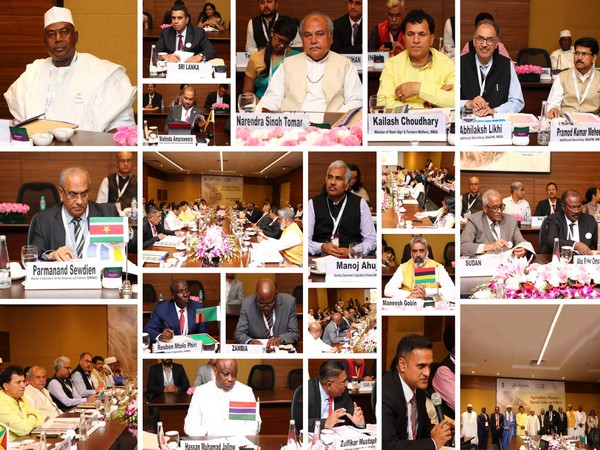India hosts roundtable on millets to strategise production and consumption globally
The government of India under Prime Minister Narendra Modi spearheaded the United Nations General Assembly (UNGA) resolution for declaring the year 2023 as the International Year of Millets and the proposal of India was supported by 72 countries.

- Country:
- India
A ministerial round table of millets was held post-inaugural session of the Global Millets (Shree Anna) Conference in New Delhi on Saturday. Ministers from Guyana, Mauritius, Sri Lanka, Sudan, Suriname and Zambia; Permanent Secretary, Agriculture of Gambia and Maldives and Director General, Millets Initiative, Nigeria participated in the meeting.
India held its first mega-global event Global Millets (Shree Anna) Conference in Delhi to celebrate 2023 as the International Year of Millets (IYM). The aim of United Nations to declare 2023 as the International Year of Millets on India's initiative is to elevate awareness of millets for food security and nutrition, enhance investment in R&D and extension, and to inspire stakeholders towards improving production, productivity and quality of millets. On Saturday, Prime Minister Narendra Modi inaugurated the global event in the presence of Union Minister of Agriculture and Farmers Welfare Narendra Singh Tomar, among other ministers who were present.
In his opening remarks at the Ministerial Round Table, Tomar highlighted India's role in promotion, being the largest producer and second largest exporter of millets in the world. During last five years, India produced millets in the range of 13.71 to 18.02 million tonnes. In order to promote millets and meet the additional demand of millets, the government is implementing a Sub-Mission on Nutri-Cereals (Millets) under National Food Security Mission (NFSM) in 212 Districts of 14 States since 2018-19.
India exported 104,146 metric tonnes of millets during the export year 2022-23 (April to November) worth Rs 365.85 crores. Along with focusing on research and innovation in production, farmers associations namely FPOs are being encouraged, so that, aggregation, production and processing can be increased. Tomar expressed happiness at operation of many start-ups in millets with government support.
Also, the visiting ministers from major millets producing countries shared the experience of their respective countries in promoting production, consumption and branding of millets. They all favoured closer linkage among major millets producing countries. All countries desired that India should provide good seed of improved varieties of millets, help in establishing small scale mechanization and capacity building, according to a government release. All ministers supported promotion of indigenous millet crops in their countries to free people from wheat consumption.
"They suggested that millets should be declared priority crops and set agenda in all the international meetings. Some countries like Guyana which are not traditional millets growing have shifted to millets cultivation due to awareness created by International Year of Millets. India assured these countries to provide all knowledge, technology and capacity building," the release said. The International Year of Millets 2023 has officially kicked off.
The government of India under Prime Minister Narendra Modi spearheaded the United Nations General Assembly (UNGA) resolution for declaring the year 2023 as the International Year of Millets and the proposal of India was supported by 72 countries. What are millets?
Millet is a common term for categorizing small-seeded grasses that are often called Nutri-cereals. Some of them are sorghum (jowar), pearl millet (bajra), finger millet (ragi), little millet (kutki), foxtail millet (kakun), proso millet (cheena), barnyard millet (sawa), and kodo millet (kodon). An essential staple cereal crop for millions of smallholder dryland farmers across Sub-Saharan Africa and Asia, millets offer nutrition, resilience, income and livelihood for farmers, and have multiple uses such as food, feed, fodder, biofuels and brewing.
Significance and benefits of millets: Millets are nutritionally superior to wheat and rice owing to their higher protein levels and a more balanced amino acid profile. Millets also contain various phytochemicals which exert therapeutic properties owing to their anti-inflammatory and anti-oxidative properties.
Further, besides being climate resilient, millet grains are rich sources of nutrients like carbohydrates, protein, dietary fibre, and good-quality fat; minerals like calcium, potassium, magnesium, iron, manganese, zinc and B complex vitamins. Most importantly, millet production is not dependent on the use of chemical fertilizers.
Background of millets in India: Millets were traditionally consumed, but due to the push given to food security through Green Revolution in the 1960s, millets were less consumed and almost forgotten.
Before the Green Revolution, millets made up around 40 per cent of all cultivated grains, which has dropped to around 20 per cent over the years. India produces all the nine commonly known millets and is the largest producer and fifth-largest exporter of millets in the world.8 Most of the states in India grow one or more millet crop species. Rajasthan, Uttar Pradesh, Haryana, Gujarat, Madhya Pradesh, Maharashtra, Karnataka, Tamil Nadu, Andhra Pradesh, and Telangana are the major millets producing states. (ANI)
(This story has not been edited by Devdiscourse staff and is auto-generated from a syndicated feed.)










